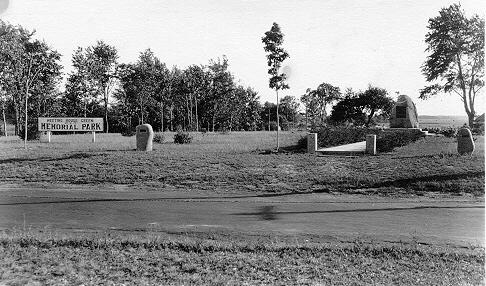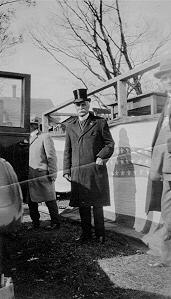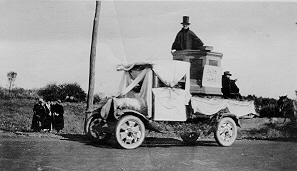By Bonnie Meroth
Atlantic News, Thursday, August 21, 1990

The time was October, 1925. The young, slim deciduous trees had not yet lost their leaves to winter's cold. Set sparsely, stark against the cool mid—autumn sky, they dotted a triangular shaped grassy green.
In the center of this small plot of land, a huge granite boulder rested majestically atop a cement platform around which newly planted flowering shrubs were growing. A few nearby evergreens offset the three-sided symmetry of the carefully planned landscape, the sameness in shape as the huge stone.
The face of the large rock bore a memorial inscription, squarely set in metal against the 12-ton boulder:
Rev. Bachiler's little band of pioneers grew over the next 300 and more years into the thriving town of Hampton. The spot on which they first settled is now a lovely residential area near Park Avenue. The three-sided memorial green outlined by Park Avenue, Landing road and Cuss Lane now pays homage to the site of Hampton's first meeting house and the area in which the early settlers made their homes in the place they called "Winnacunnet," an Indian word for "beautiful place of the pines."
Meeting House Green Memorial Park, allowed the familiar sobriquet of "Founder's Park," bears not only the distinct central stone, but 38 smaller perimeter stones, co m me m orative companions bearing the names of families who founded Hampton. Corner stones note eight of the nine towns which were originally part of Hampton: East Kingston, Kingston, Kensington, Sandown, Danville, Hampton Falls, Seabrook, North Hampton and Hampton. For unknown reasons, Rye, also an ancestral part of Hampton, was omitted from the original group (but added in recent years).
The primigenial families date from 1638, many names still recognized on the Hampton scene.

Rev. Ira S. Jones - 1925
According to Hampton historian, John Holman, the park was the inspiration of Rev. Ira S. Jones. Although not a native to Hampton, Rev. Jones was fascinated with the history of the town he had grown to love. He felt as though some sort of memorial should venerate the founding forefathers.
Needing funds for his goal, the good reverend procured the financial backing of philanthropist Edward Tuck of Paris, France. Land and buildings, the Fogg property on Park Avenue, were purchased with Tuck's donations.
Octogenarian Jones oversaw the undertaking of the project, also assuming the position of financial director while corresponding with Tuck in Paris. In his labor of love, Jones even physically participated in the clearing of the land for the park.
After much building renovation and landscaping, the Fogg property eventually became "Tuck Hall," now Tuck Memorial Museum, Meeting House Green Memorial Park, and later, an athletic field for the youth of the town.
Surrounding towns, contiguous sister communities represented at the park, donated their stones. In addition to the center and family stones, 55 trees were planted on the triangle in memory of the older families in Hampton.
The dedication ceremony of Founder's Park took place on October 14, 1925 the fourteenth of October matching the approximate date that Rev. Bachiler and his group sailed up the Hampton River.

Original Congregational Church pulpit on display at 1925 dedication of Founder's Park at Meeting House Green in October 1925. Standing: Charles M. Batchelder; Others on float: Fred B. French, 86 of South Hampton, NH, and James W. Perkins, 90 of Hampton, NH.
A long, elaborate parade, delineating scenes from important events in the town with illustrious residents marched as part of the dedication activities and pageantry. Even the Spirit of '76 with fife and drum was on hand.
Direct descendants of the founding reverend, Horace Batchelder and his sister Elsie, unveiled the memorial boulder at the dedication attended by citizens and dignitaries.
As Rev. Ira Jones, in tall top hat and coattails, proudly watched, the founders of Hampton were immortalized "as an inspiration to posterity" and "in behalf of the inhabitants of the original grant to Stephen Bachiler and his little band of pioneers."
Rev. Jones was able to enjoy the realization of his dream for two years before he died 24 months after the dedication.
Meeting House Green Memorial Park remains as silent testimony by the progeny of Hampton's first settlers who dared to brave the wilderness at Winnacunnet.
The center monolithic marker and smaller grey stones with metal plaques, weathered with tarnish over the last 65 years, stand under the now fully grown groves of trees, grown to tall sentinels which guard the stones which tell all that once there was a "little band of pioneers."
